Be the eyes, the ears, the brain, the mouth, and the hand: the secret to organizing devday, an…
Over the last two weeks I had the wonderful opportunity of organizing and giving a talk at a dev event. I jumped at it, I’ve always wanted…

Be the eyes, the ears, the brain, the mouth, and the hand: the secret to organizing devday, an event of, for, and by, devs
Over the last two weeks I had the wonderful opportunity of organizing and giving a talk at a dev event. I jumped at it, I’ve always wanted to do something like that. Four of us quickly teamed up to organize things, but the event was carried by each and every one at Sahaj. I’m currently beaming with pride: I was a part of a team that had made the best of the opportunity — we were able to bring in a wonderfully inquisitive crowd of 30 people. At our first event.
And we’re just getting started.
NOTE: This is a personal account of my enthusiasm, expectations, and experiences, and nothing else. Any other interpretations are unwarranted. This is an important milestone in my journey, which is why it is here.
So, what was the event ?
Here’s a hint: it’s of, for, and by, devs
Sahaj had been conducting a monthly event where developers meet and discuss technology for over 4 months, at Bangalore. It was called Devday, and even sported a cool description:
DEVDAY is a monthly informal event for developers to share their experiences, ideas, opinions & perspectives about technology.
As soon as I knew about it, I wanted to be a part of organizing such an event at Chennai. Because, why not? After all, Chennai is my city, and I love bringing people with an interest in technology together. After the boom of open source online collaboration, it’s something I’d become very interested in. It would open up a lot of avenues for growth, both personal and career-based, for all the people involved. If there is a chance of meeting new people, network, and also grow collectively, who wouldn’t? Collaboration is always for the win.
The way I saw it, we needed to amass a driving force of innovation in the technology sector, powered by people from various backgrounds, including scientists, students, technologists, hackers, geeks, and whoever is even mildly interested in technology of any kind. For simplicity, and nothing else, I’ll be calling these people devs.
Sahaj was prepared to host the event in its Chennai office — moved recently into Thiruvanmiyur, the heart of the corporate part of the city — an advantage which I hoped to play to its fullest. I could be a part of a start of something huge.
I had also recently come across a wonderful JavaScript framework, which felt very natural and intuitive for me to code on, called Cycle.js. I was looking for a public space to speak about it and get more people interested in it. And this could be the nudge I needed.
With these thought in mind, I wanted to be an integral part of the first Devday in Chennai. I asked for the opportunity to do the same, and Sahaj accepted — they’re cool that way. A few people quickly signed up to help organize, and each one of us were the owners of the event ever since.
Be the brain, and the hand
Foresee what should be done, and write a checklist
I’ve been a member of the Scouts and Guides movement, and I’ve always loved the motto: Be Prepared. I have sometimes thought that it’s just too hard, but I was keen on not making that excuse this time. There would always be some variables, but we must be as prepared as we can foresee. Even though I’d wanted to be a part of something like this, I’d neither had the opportunity, nor the skill to create an opportunity where there wasn’t one. I wasn’t ready to botch this — this was my first big break.
Make the best of every opportunity you get, most people don’t get them.
We had to
- update the website
- broadcast on twitter
- have a presence on facebook
- create a meetup page
- focus on a theme for the first event
- call in speakers for the event
- get people engaged
- get the office space ready to host the event
- host the event
- get and process feedback
Each of these was a huge undertaking, and we worked on it with as much enthusiasm anyone could muster. After all, like I said, it was everybody’s own event.
Be the eyes, the ears, and the brain
Sense the pulse, and evaluate a theme that makes sense
One of the most important tasks in organizing a successful event of any kind is to feel the pulse of the intended audience and go along with it. Our agenda was clear: bring devs together and fuel innovation, while enabling the sharing of skills and knowledge.
To me, it was simple — we just had to find out what people were interested in, and then, people willing to share on the subject, and connect them; we could then sit back and revel in whatever outcome we have.
“A good teacher — like a good entertainer — first must hold his audience’s attention; then he can teach his lesson.”
— John Henrik Clarke
JavaScript was a good start. There was so much happening with the single programming language that we couldn’t stay out of it. Interest in Internet of Things (IoT) was huge at the moment, but there were just too many IoT events going on that we would find it tough to break through the noise when we had to market the event.
It was collectively decided that the theme of the first event was to be JS Everywhere, JS being short for JavaScript. I was pretty happy with the title. But we didn’t lose any momentum from the interest in IoT, as we also had an IoT in JavaScript talk planned.
Be the brain, the mouth, and the eyes
Formulate a message, spread the word, and see if they’ve listened
I would never agree that speaking is an activity done exclusively by the mouth. You can use gestures, but that’s not exactly what I’m talking about here. It is always fruitful to think before we talk, and we use the brain. Then, as usual, we expect visual feedback to confirm that we got the message across.
Finalizing the line up of talks
Probably the first thing to finalize
We could always go out and find people who would share things at our event, but I had my inhibitions. For instance, this was our first event — our recognition was limited. Not many speakers would venture into a first event: they wouldn’t know what to expect of the crowd. So we had to look at other options as a fallback.
In case we were not able to source as many external speakers as we would like, we needed to fill the gap with the talent pool at Sahaj — there was no way they would not attend the event. After a lot of discussion, it was planned to have 4 20-minute talks, with 10 minutes of questions time.
A special mention to Vagmi Mudumbai here who ventured into the unknown by signing up with the event as a speaker. As was said at the event, he will always be the first external speaker at Devday Chennai, and no one can take that away from him.
I think we had around a week to go before the event, and we had to quickly set the list of talks in stone so that we can look at other challenges. Vagmi joined us, and I was already set to give a talk on Cycle.js. Sahaj provided 2 more talks, each revolutionary in their own respect.
We had four talks lined up:
- Creating offline/desktop applications using Electron, by Sairam,
- Building native mobile applications using React Native, by Vagmi,
- Functional Reactive Programming with Cycle.js, by yours truly,
- IoT using Johnny-Five, by Raj.
I felt really good — everything was falling beautifully in place with our theme. JavaScript really was everywhere: from the web, to the desktop, to native mobile applications, to IoT. And we had the line-up ready to touch upon each of it.
EDIT: I just checked our github commit history to confirm that we finalized the speakers a mere 8 days before the actual event. Yes, the website is open sourced.
Reaching out to the prospective audience
Equally important, but better once you have a set of talks lined up
The first task after finalizing the speakers was to update the website, add a facebook event, and share it on any social medium we had an impact in. The meetup page for the event was also up, and we had started sharing links to each of these to our respective networks, our friends, and people we thought were interested in what we had to offer.
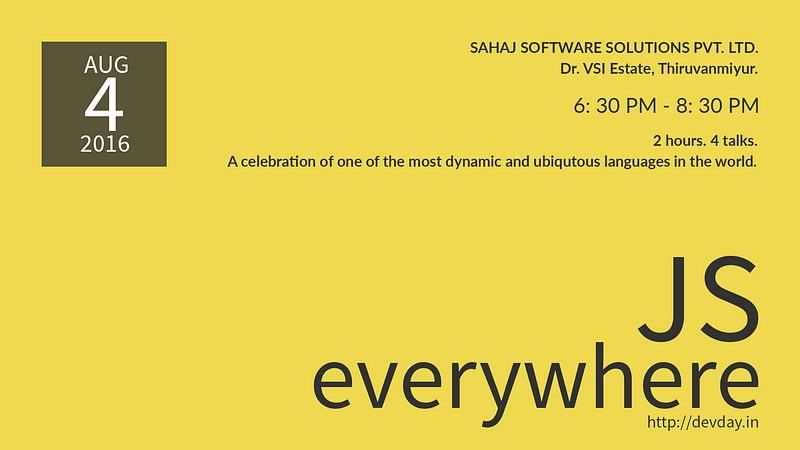
We had 57 people registering from the meetup page, and another 15 from the website (which I think we didn’t promote as much as we should have, looking back now). While people reminded me to keep myself grounded, and expect 10-15% of the people to show up, I was excited. I had done my homework — people were interested in JavaScript — and we had a variety of talks that truly showed that JavaScript was everywhere. I was hoping for at least 30% to show up.
We had formulated a message, spread the word, and people had listened. Now all that was left was to measure the impact.
No matter how many show up, we were gonna do what we planned: share stuff, engage with them, and provide them a positive experience, so that the interest in Devday is organically grown. We absolutely also had to collect feedback on what worked and what didn’t — after all, everything we do has a feedback loop, and we must harness it.
Be the hand, and, well, everything else
Get things running, analyze the situation, and then go back to step 1
There were wonderful people at Sahaj who got most of the things setup, like the internet, the projectors, the speakers, and the mics, so I couldn’t go into detail into those aspects even if I wanted to.
I remember the first of the audience joining us at 5.30 PM. The event was supposed to start at 6.30 PM. I got really excited, and so did others.
People from Sahaj were interacting with him, while I was still preparing my slides for my own talk. We didn’t have another attendee until somewhere close to 6.10 PM, and things seemed bleaker than I had anticipated. There’s still time, I convinced myself. Some people probably had to travel and stuff, that too in peak traffic hours.
The introductory session
Every story starts somewhere — or does it?
By 6.30 PM we had a decent show of around 25 people. We were really excited. Swami from Sahaj offered to give an introduction, and we took it. What followed was a curiously entertaining blend of light-hearted but pensive introduction to what Devday stands to mean.
Him being probably the only non-techie in the entire flock, I was happy to see the crowd responding positively to his unique weave of thoughtful reaffirmations and jests.
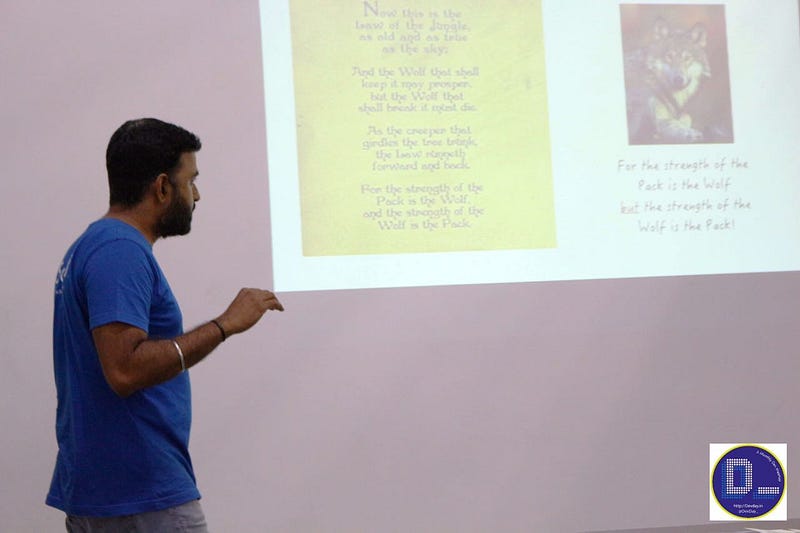
Opening with our strengths
The first talk is important — it should attract and hold people, so that the speakers who follow have an eased-in audience.
One of the best ways a speaker can show himself to be seasoned to is to ascertain the mood of the crowd and adjust his agenda and talk accordingly. Sairam, also from Sahaj, had seen the crowd have a good time with the jokes that Swami had been making, and pitched in with a few of his own.
As the talk progressed, Sairam showed his mettle with a github repo that can later be accessed if someone wanted to revisit the topic. He also used a local clone of the repo in order to go step by step from a basic hello world electron app to one with a UI based on React and then one with persistence using pouchdb.
Being experienced, he knew just when to stop — just as the audience had accrued enough interest — so that they would definitely look these up later.
You can find more material from his talk at the meetup page
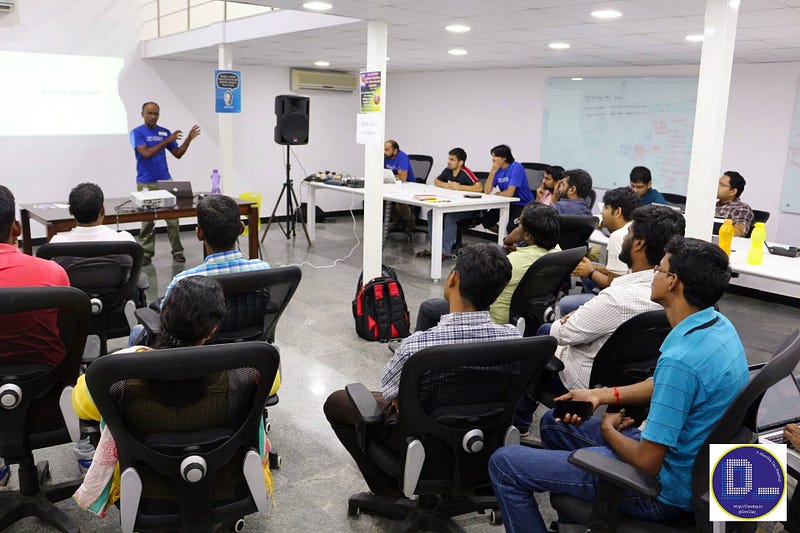
Letting the guest speaker rule
The guest speakers have to have a positive experience, if we expect them to revisit or recommend us to other speakers in the future
Vagmi was no newbie to speaking — he had several talks to his credit — and his session, I felt, seemed more like a professional conference lecture. There were only slides with headlines: everything he spoke was a continuous stream of thoughts flowing from his mind, he didn’t even have to pause to look at his slides often.
The transition from slides to hands-on coding was done in a sleight-of-hand fashion, and several aspects of where React Native helps — and where it falls short — were explained beautifully. I wish to engage with him more in the future.
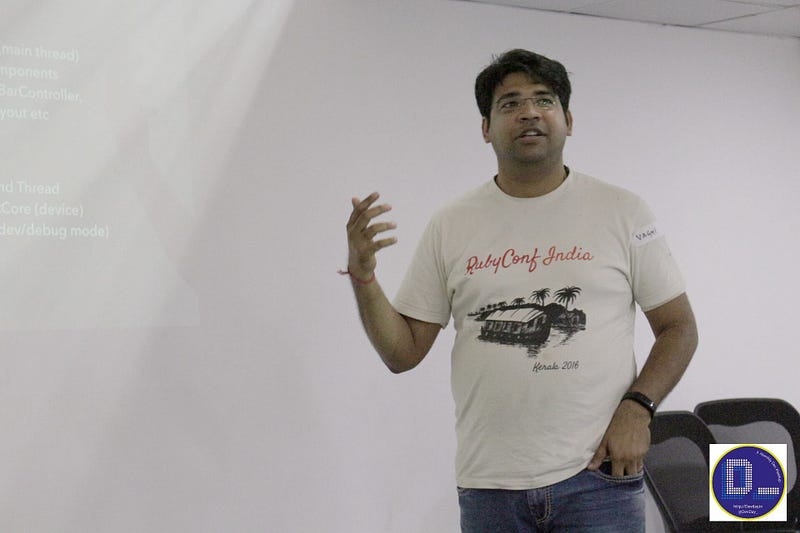
Learning to ride the cycle
My talk on Functional Reactive Programming with Cycle.js
I had been preparing for the event only from that morning, since I’d been busy with the organizing stuff all through the past two weeks. I had a lot to cover, and 20 minutes was appalling. Swami had so far done a wonderful job of making the speakers stick to the timelines, and I was up next — with my approximately 140 slides.
This being my first talk, I was a bit nervous. But once I started, I think I had a confident flow of thoughts. I was very comfortable with FRP in general, and Cycle.js in particular, and I was extremely familiar with the slides — I’d just finished creating them.
Hosting the slides on slides.com was something I was looking forward to. I wanted to use my phone as a remote control to control the presentation and wanted to host it live so that people with their laptops can follow the live presentation.
It worked, but sadly I wasn’t so prepared as I had thought — my laptop’s screen kept going blank as my MacBook Pro kept going to sleep without any activity. I should’ve changed the settings, I just hadn’t thought that far. Then something else happened as my slides were no longer changing, and I didn’t have time to troubleshoot, so I just started using my laptop to change the slides.
As I finished up with my presentation, I could see that some in the audience were left with something wanting, but I had no time to inquire — I had used up 30 minutes of my time, and had no time to take questions. With some nervousness, I made way for the next speaker, after sharing my twitter and github profiles, and the link to the presentation. I’ve done okay, I thought. It’s good for a start.
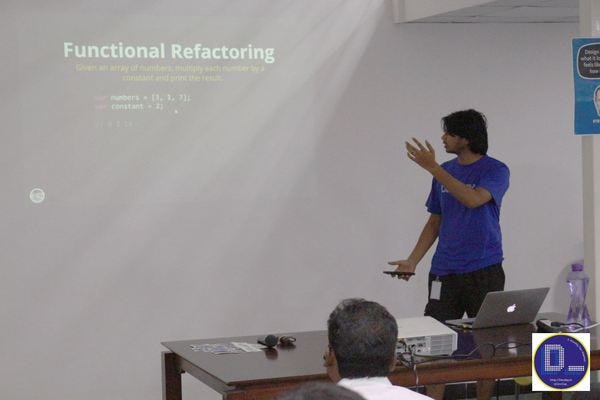
The LED at the end of the tunnel
There is always light at the end of the tunnel, we just made it a green LED.
Without taking any credit away from the other speakers, this was the most interactive session. It was handled by Raj, also from Sahaj, in a very interactive fashion, and had a couple of audience-wide applause. He had introduced IoT to them using JavaScript.
There were also some questions asked to which people from the audience also were able to share their experiences and ideas. It was cool to realize that the IoT card which we played last paid off. I also hijacked the session’s end in order to introduce people to a project we (Raj and myself) were working on — to bring JavaScript devs closer to the IoT and SoC space — called RIoT.
You can get more material from his talk here, at the meetup page.
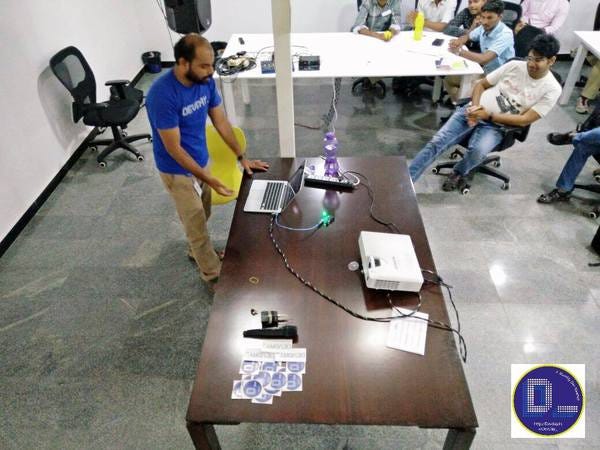
The networking end to the JavaScript event
Allow time for people to network, the audience might have some unresolved questions
After the last talk, and my hijacking of it, we were about to open things up with time for networking. I wanted to speak to Vagmi about his session and React in general and try to get him to use Cycle.js in his next project. Several other people from the audience had questions for him as well. He even congratulated me on my presentation. I still remember the feeling.
Sahaj had meanwhile ordered about a dozen large pizzas for everyone in the room, and had also brought us some feedback forms. Sahaj rocks!
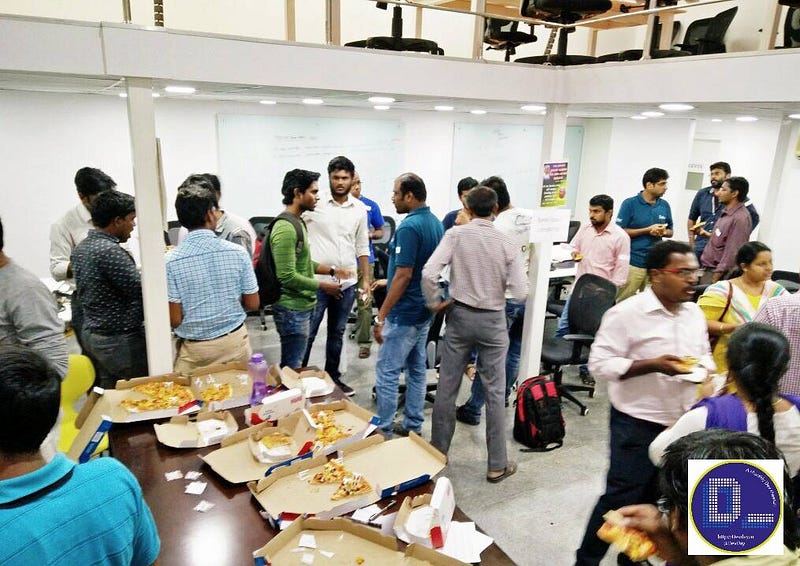
This time was something I was very happy with: time with people who were mostly interested in the same things as myself, for the most part. Many people had a lot to share — and a lot of pizza to eat — while filling the feedback forms. A guy even walked up to me to ask about Cycle.js!
I also remember people who were talking about IoT with Raj, about Electron with Sairam, and even among themselves. If there was one thing I’d want to do better next time, it would probably be the networking bit. Although I don’t know how, I feel we could’ve done it in a better way.
Be the eyes, and the brain
See the feedback, and create action items for the next event
We had, by the time everyone left, about a dozen feedback forms needing our attention the next morning. Most people had asked for longer sessions, deeper sessions. Some of them wanted the event to fall on a weekend, and these were things that I knew Sahaj will take seriously. We could take a look at them in the morning. For now, I just wanted to get home.
Be the eyes, closed
Revel in the feeling of what you have brought about
I felt famished — after having had almost half a large pizza, and some exotic garlic bread — but not for food. I had a feeling of achievement, accomplishment, reaching a target, whatever else you could call it. And I was looking for more.
I think it was probably the happiest that I had been in a long time, going home at around 11 PM, riding a moped, my mind filled with all the things that had happened that day: a sign of progress for me, a milestone reached. I had organized my first event. I had given my first talk.
And I’m just getting started.
FULL DISCLOSURE
I am a Sahajeevi myself, which goes to say that I’m a part of Sahaj as a community. Although that is how we talk, to put it in plain words, I’m an employee of Sahaj. But — and this is most important — the views and sentiments expressed in this article are my own and are not influenced by Sahaj in any way.
From my experience with Sahaj, it’s more like a community with awesome people, rather than a place to work. Do you like what Sahaj does? Reach them via email or twitter.
If you would like to contribute towards devday, you can email me, or reach me on twitter, or email the devday teams at devday.blr@gmail.com, and devday.chn@gmail.com, or reach them on twitter.